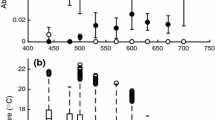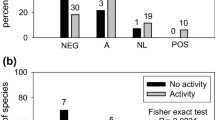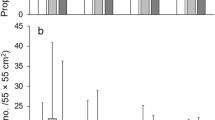Abstract
Two classes of explanations for covariation between activity level and metabolic rate among conspecifics have been proposed. First, individual-level variation in activity exhibited during the measurement of metabolic rate should covary with routine metabolic rate because movement increases respiration (a methodological relationship). Second, energetic-based hypotheses posit relationships between individual activity measured under more natural conditions and baseline measures of metabolic rate, among other behavioral, physiological, and life-history traits (functional relationships). Here, we examined these potential relationships between individual behavior and metabolic rate in the mud crab (Panopeus herbstii). Specifically, we tested for (1) an effect of crab activity in metabolic chambers (activitychamber) on routine metabolic rate (RMR), and (2) an effect of crab activity in mesocosms that mimicked field conditions (activitymesocosm) on standard metabolic rate (SMR). To test for context dependence, we assessed both activity-metabolic rate relationships in the absence and presence of predation threat from toadfish (Opsanus tau) in the form of waterborne chemical cues. Individual variation in activitymesocosm and RMR was repeatable over time. In support of a methodological relationship, individual differences in RMR were partially explained by crab activitychamber. After accounting for this methodological relationship, individual SMR was inversely related to activitymesocosm, supporting an allocation model that predicts behavior and baseline metabolic rate compete for finite energy reserves. We found no evidence of context dependence in either activity-metabolic rate relationship. Thus, our study emphasizes the importance of considering methodological artifacts in elucidating functional relationships between individual behavior and energetics.




Similar content being viewed by others
References
Anholt BR, Werner E, Skelly DK (2000) Effect of food and predators on the activity of four larval ranid frogs. Ecology 81:3509–3521
Bell AM, Hankison SJ, Laskowski KL (2009) The repeatability of behaviour: a meta-analysis. Anim Behav 77:771–783
Bell AM, Sih A (2007) Exposure to predation generates personality in threespined sticklebacks (Gasterosteus aculeatus). Ecol Lett 10:828–834
Biro PA, Stamps JA (2008) Are animal personality traits linked to life-history productivity? Trends Ecol Evol 23:361–368
Biro PA, Stamps JA (2010) Do consistent individual differences in metabolic rate promote consistent individual differences in behavior? Trends Ecol Evol 25:653–659
Bolker BM, Brooks ME, Clark CJ, Geange SW, Poulsen JR, Stevens MHH, White JS (2009) Generalized linear mixed models: a practical guide for ecology and evolution. Trends Ecol Evol 24:127–135
Bouwhuis S, Quinn JL, Sheldon BC, Verhulst S (2014) Personality and basal metabolic rate in a wild bird population. Oikos 123:56–62
Briffa M, Bridger D, Biro PA (2013) How does temperature affect behaviour? Multilevel analysis of plasticity, personality and predictability in hermit crabs. Anim Behav 86:47–54
Buchanan KL, Evans MR, Goldsmith AR, Bryant DM, Rowe LV (2001) Testosterone influences basal metabolic rate in male house sparrows: a new cost of dominance signalling? Proc R Soc B 268:1337–1344
Burton T, Killen S, Armstrong J, Metcalfe N (2011) What causes intraspecific variation in resting metabolic rate and what are its ecological consequences? Proc R Soc B 278:3465–3473
Careau V, Buttemer WA, Buchanan KL (2014a) Developmental stress can uncouple relationships between physiology and behaviour. Biol Lett 10:20140834
Careau V, Garland T Jr (2012) Performance, personality, and energetics: correlation, causation, and mechanism. Physiol Biochem Zool 85:543–571
Careau V, Killen SS, Metcalfe NB (2014b) Adding fuel to the “fire of life”: energy budgets across levels of variation in ectotherms and endotherms. In: Martin LB, Ghalambor CK, Woods HA (eds) Integrative organismal biology. Wiley-Blackwell, Hoboken, pp 219–233
Careau V, Thomas D, Humphries M, Réale D (2008) Energy metabolism and animal personality. Oikos 117:641–653
Clarke A, Johnston NM (1999) Scaling of metabolic rate with body mass and temperature in teleost fish. J Anim Ecol 68:893–905
Crawley MJ (2009) The R book. John Wiley and Sons, West Sussex
Dall W (1986) Estimation of routine metabolic rate in a penaeid prawn, Penaeus esculentus Haswell. J Exp Mar Biol Ecol 96:57–74
Deerenberg C, Overkamp G, Visser G, Daan S (1998) Compensation in resting metabolism for experimentally increased activity. J Comp Physiol B 168:507–512
Galliard JF, Paquet M, Cisel M, Montes‐Poloni L (2013) Personality and the pace-of-life syndrome: variation and selection on exploration, metabolism and locomotor performances. Funct Ecol 27:136–144
Gifford ME, Clay TA, Careau V (2014) Individual (co) variation in standard metabolic rate, feeding rate, and exploratory behavior in wild-caught semiaquatic salamanders. Physiol Biochem Zool 87:384–396
Gosling SD (2001) From mice to men: what can we learn about personality from animal research? Psychol Bull 127:45–86
Grabowski JH (2004) Habitat complexity disrupts predator-prey interactions but not the trophic cascade on oyster reefs. Ecology 85:995–1004
Griffen BD, Toscano BJ, Gatto J (2012) The role of individual behavior type in mediating indirect interactions. Ecology 93:1935–1943
Guenther A, Finkemeier M-A, Trillmich F (2014) The ontogeny of personality in the wild guinea pig. Anim Behav 90:131–139
Killen SS (2014) Growth trajectory influences temperature preference in fish through an effect on metabolic rate. J Anim Ecol 83:1513–1522
Killen SS, Marras S, Metcalfe NB, McKenzie DJ, Domenici P (2013) Environmental stressors alter relationships between physiology and behaviour. Trends Ecol Evol 28:651–658
Kralj-Fišer S, Schuett W (2014) Studying personality variation in invertebrates: why bother? Anim Behav 91:41–52
Krams I, Kivleniece I, Kuusik A, Krama T, Freeberg TM, Mänd R, Vrublevska J, Rantala MJ, Mänd M (2013) Predation selects for low resting metabolic rate and consistent individual differences in anti-predator behavior in a beetle. Acta Ethol 16:163–172
Krupa JJ, Sih A (1998) Fishing spiders, green sunfish, and a stream-dwelling water strider: male-female conflict and prey responses to single versus multiple predator environments. Oecologia 117:258–265
Lessells C, Boag PT (1987) Unrepeatable repeatabilities: a common mistake. Auk 104:116–121
Lima SL, Dill LM (1990) Behavioral decisions made under the risk of predation: a review and prospectus. Can J Zool 68:619–640
Nakagawa S, Schielzeth H (2010) Repeatability for Gaussian and non-Gaussian data: a practical guide for biologists. Biol Rev 85:935–956
Nespolo RF, Franco M (2007) Whole-animal metabolic rate is a repeatable trait: a meta-analysis. J Exp Biol 210:2000–2005
Niewiarowski P, Waldschmidt S (1992) Variation in metabolic rates of a lizard: use of SMR in ecological contexts. Funct Ecol 6:15–22
Core Team R (2012) R: a language and environment for statistical computing. R Foundation for Statistical Computing, Vienna, Austria
Réale D, Garant D, Humphries MM, Bergeron P, Careau V, Montiglio PO (2010) Personality and the emergence of the pace-of-life syndrome concept at the population level. Phil Trans R Soc B 365:4051–4063
Sarà G, Palmeri V, Montalto RA, Widdows J (2013) Parameterisation of bivalve functional traits for mechanistic eco-physiological dynamic energy budget (DEB) models. Mar Ecol: Prog Ser 480:99–117
Siepielski AM, Wang J, Prince G (2014) Nonconsumptive predator-driven mortality causes natural selection on prey. Evolution 68:696–704
Sih A, Bell A, Johnson JC (2004) Behavioral syndromes: an ecological and evolutionary overview. Trends Ecol Evol 19:372–378
Sih A, Cote J, Evans M, Fogarty S, Pruitt J (2012) Ecological implications of behavioural syndromes. Ecol Lett 15:278–289
Speakman JR, Król E, Johnson MS (2004) The functional significance of individual variation in basal metabolic rate. Physiol Biochem Zool 77:900–915
Svanbäck R, Eklöv P (2011) Catch me if you can—predation affects divergence in a polyphenic species. Evolution 65:3515–3526
Toscano BJ, Griffen BD (2014) Trait-mediated functional responses: predator behavioural type mediates prey consumption. J Anim Ecol 83:1469–1477
Toscano BJ, Fodrie FJ, Madsen SL, Powers SP (2010) Multiple prey effects: agonistic behaviors between prey species enhances consumption by their shared predator. J Exp Mar Biol Ecol 385:59–65
Toscano BJ, Gatto J, Griffen BD (2014) Effect of predation threat on repeatability of individual crab behavior revealed by mark-recapture. Behav Ecol Sociobiol 68:519–527
White CR, Schimpf NG, Cassey P (2013) The repeatability of metabolic rate declines with time. J Exp Biol 216:1763–1765
Widdows J, Staff F (2006) Biological effects of contaminants: measurement of scope for growth in mussels. ICES Tech Mar Environ Sci 40:1–30
Wiersma P, Verhulst S (2005) Effects of intake rate on energy expenditure, somatic repair and reproduction of zebra finches. J Exp Biol 208:4091–4098
Wikelski M, Lynn S, Breuner J, Wingfield J, Kenagy G (1999) Energy metabolism, testosterone and corticosterone in white-crowned sparrows. J Comp Physiol A 185:463–470
Acknowledgments
This study was supported by a NSF Graduate Research Fellowship (under Grant No. DGE-0929297) and a SPARC Graduate Research Fellowship (University of South Carolina) to BJT, and a GAANN Fellowship (Fellowship No. P200A090301) to CJM. Partial funding was further provided by NASA (NNX11AP77G). This is contribution number 81 in Ecological Forecasting from the University of South Carolina. We thank J.M. Harding and P.D. Kenny for technical assistance, and B.D. Griffen, K. Niitepõld, J.L. Dudycha, and anonymous reviewers for helpful suggestions that improved the manuscript.
Author information
Authors and Affiliations
Corresponding author
Additional information
Communicated by T. Breithaupt
Rights and permissions
About this article
Cite this article
Toscano, B.J., Monaco, C.J. Testing for relationships between individual crab behavior and metabolic rate across ecological contexts. Behav Ecol Sociobiol 69, 1343–1351 (2015). https://doi.org/10.1007/s00265-015-1947-4
Received:
Revised:
Accepted:
Published:
Issue Date:
DOI: https://doi.org/10.1007/s00265-015-1947-4




